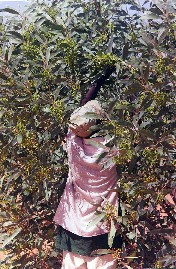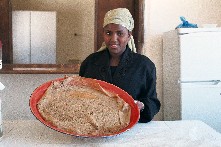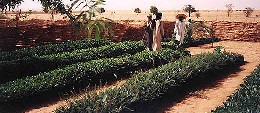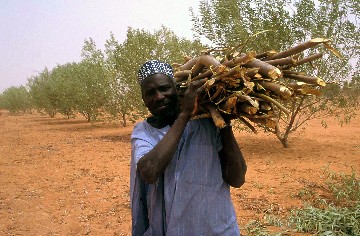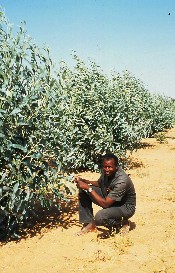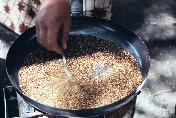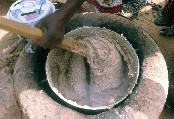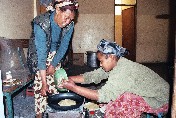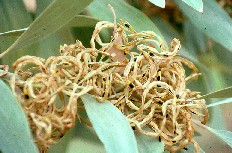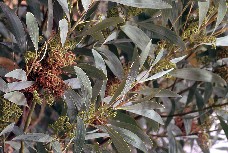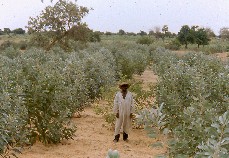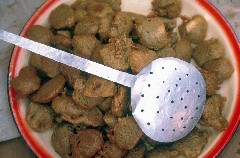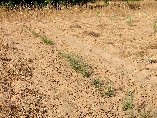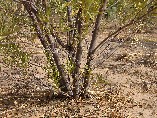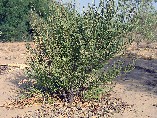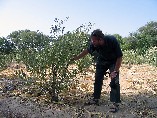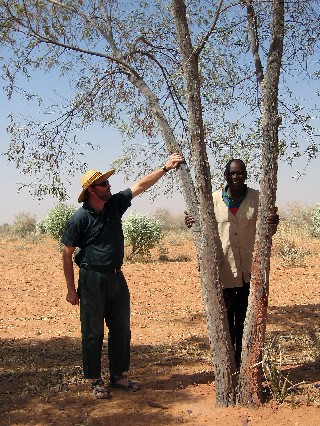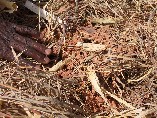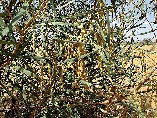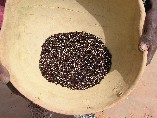| Text by: |
|
|
|
|
|
Human populations living in semi-arid regions of the developing, tropical world who are reliant on annual crops and/or pastures (for livestock) for food are particularly vulnerable to hunger and periodic famine. This is especially evident in sub-Saharan Africa. In our 2002 paper 'Potential of Australian Acacias in combating hunger in semi-arid lands', attention was drawn to the vast, untapped potential of certain Australian Acacia species as new food crops, worthy of larger scale promotion, particularly in semi-arid regions of the world.
|
|
|
Acacia as human food
A number of species of edible-seeded Australian acacias thrive under adverse conditions; conditions under which many annual plants barely survive. The seeds of these species are tasty, safe to consume and nutritious, being high in protein, carbohydrates and fats. Being perennial and thus having an established root system, mature acacias can take advantage of rains that would be ineffective for annual crops (e.g. out of season or poorly distributed rains). Acacia seeds are easily harvested and processed into flour using simple and existing local technologies. The flour can be incorporated into local dishes and in "non traditional" foods such as spaghetti, bread and biscuits. The seed also has great potential as livestock feed. Alternatively, the hard-coated seeds can easily be stored for many years and act as a famine reserve food.
|
|
|
|
|
Acacia colei
Acacia colei is one of the introduced Australian species that is commonly used as a human food in sub-Saharan Africa . This species comprises two varieties, var. colei and var. ileocarpa, which are distinguished by their pods, curved in the former and tightly coiled in the latter. Both varieties are used but they have different characteristics that affect their utilisation. There is no distinction in taste between the two varieties, however physical differences in their seed pods have a large bearing on convenience of harvesting.
For var. ileocarpa, seeds are held firmly in their coiled pods, hence ripe pods can be left on the tree longer without seed loss. Pickers can wait for a high proportion of the pods to ripen before harvesting, spending less time on repeat harvests. Additionally, even though the pods hold seed longer, once fully dry, a light beating with a stick will separate seed from pods.
In West Africa, var. colei pods ripen unevenly, and seed begins to drop from pods within a day or so of ripening. Thus, pickers must return daily to harvest newly ripened pods.
Alternatively, pods of both varieties can be picked slightly green and laid on a mat to dry in the sun. Even so, losses from shattering are less likely with var ileocarpa, giving farmers more flexibility.
|
|
|
Sahelian Eco-Farm Concept
In some areas, considerable effort has gone into promoting edible seeded Australian acacias for direct human consumption, but adoption has been low. Meanwhile, Professor Dov Pasternak, working at the ICRISAT Sahel Center in Niger Republic has given a new direction and momentum by using acacia trees as the backbone of his Sahel Eco Farm (SEF) concept. The annual biomass produced by Acacia colei and A. tumida is three fold higher than the biomass produces by local trees. Their very high biomass production is the key to greatly lifting yields of millet, the staple crop in the region - through mulch on an annual basis, organic matter incorporation into the soil, including root biomass after coppicing, nitrogen fixation, and wind break effect. Pruned trees provide firewood and coppice regrowth provides an average 2kg of seeds per year with a 25% crude protein content which are used for chicken feed.
|
|
|
Acacia saligna
Acacia saligna has been planted extensively on barren hillsides in Ethiopia by government and various non government organizations. World Vision is currently exploring potential human food uses of this versatile species. So it has been mixed at a ratio of 1 part saligna to 3 parts corn flour to make bread, and 1 part saligna to 3 parts teff (Eragrostis sp.) flour to make Injera, a very popular traditional flat bread used in many parts of Ethiopia. A number of cooking demonstrations have been held and the foods were well received, but no data is available yet on possible adoption rates.
Information on A. saligna research is presented elsewhere on Worldwidewattle.
Continuing Research Efforts (Acacia torulosa)
Staff of the Niger National Research Centre (INRAN) and SIM International continue to research potential uses and roles of Australian acacias in Sahelian farming systems. In their recent paper, Domestication of Australian Acacias for the Sahelian zone of West Africa, Cunningham and Abasse summarize past and present development and domestication achievements and outline current research activities. They propose future research directions and call for a long-term collaborative approach to ensure these species are domesticated and their long recognized potential becomes a reality. Until this time, much of the research and development effort has focused on A. colei. Even so, constraints of A. colei and the impressive growth and yield characteristics of A. torulosa has resulted in INRAN and SIM focusing their present research activities on the latter.
Under climatic conditions in Maradi, direct sowing of A. colei has given generally poor results. Acacia torulosa on the other hand has larger seed and early indications are that this species is much more suitable for direct sowing. This is a great advantage as it will enable poor farmers to by pass the relatively expensive and labour intensive process of raising trees in nurseries. As with A. colei, termites eat and incorporate the phyllodes of A. torulosa into the soil, thus increasing fertility. In the Sahel region termites perform the same tasks undertaken by earth worms in temperate climates, hence they are important for incorporation of organic matter into the soil, soil aeration and water infiltration. Termites are significant in the low nutrient, low organic matter soils of Niger where few farmers can afford organic or inorganic fertilizers and yields of millet average only 250-300Kg per hectare nationally. The ability of plants to coppice is a big advantage in countries such as Niger where there is high pressure on trees for wood and farmers are very attracted to the rapid returns through sale of firewood. Acacia torulosa responds well or pruning either at ground level or at one meter. An arborescent form of A. torulosa is well suited to producing medium sized poles and this is eagerly sought after for local building tasks (huts, fencing, etc.) and provide good economic incentive to farmers to plant A. torulosa. Acacia torulosa has large pods that are easily harvested. Furthermore, this species has large seeds which give it several advantages over those of A. colei for processing, namely, ease of harvest, ease of removing seeds from the pods and ease of separating the flour (germ) from the seed coat.
It should be noted that Acacia domestication and promotion in Niger is being undertaken simultaneously with a very successful program of promotion of natural regeneration of the indigenous flora.
|
|
|
|
|
|
|
|
|
|
|||
Some useful links
Developing Australian Acacias as a human food for the Sahel. Paper by C.H. Harwood, T. Rinaudo and S. Adewusi originally published in: Unasylva 50(196): 57-64 (1999).
Australian acacias -untapped genetic resources for human food production in dry tropical Sub-saharan Africa. Paper by L.A.J. Thomson, C.H. Harwood and T. Rinaudo, originally published in: FAO Forest Genetic Resources Information 24: 69-75 (1996).
Role of Acacia species in the rural economy of dry Africa and the Near East (FAO 1995). Information on uses and role of indigenous and introduced Acacia species.
Text by:
Tony Rinaudo (Senior Country Program Coordinator, Africa, Middle East and Eastern Europe team, World Vision Australia, 1 Vision Drive, East Burwood, Victoria 3151, Australia; email: rinaudot@wva.org.au) and
Lex Thomson (SPRIG Project Team Leader, Ensis, The joint forces of CSIRO and SCION (formerly Forest Research), PO Box E4008, Kingston, Canberra, ACT, 2604, Australia; email: Lex.Thomson@ensisjv.com)
